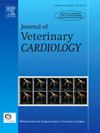Clinical utility of pharmacological defibrillation using cardioplegic solution during canine mitral valve repair
IF 1.3
2区 农林科学
Q2 VETERINARY SCIENCES
引用次数: 0
Abstract
Introduction/Objectives
Reperfusion ventricular fibrillation (VF) commonly occurs during open-heart surgery in dogs and humans. Pharmacological defibrillation using cardioplegia is a potential option; however, the standard technique remains unclear in dogs. We examined the clinical utility of pharmacological defibrillation in canine mitral valve repair.
Animals, Materials, and Methods
We retrospectively investigated 402 client-owned dogs that underwent mitral valve repair between January and December 2021.
Results
Ventricular fibrillation after cross-clamp release occurred in 70 of 397 cases (17.6%). Pharmacological defibrillation was attempted in 69 patients by administering 40 mEq/L potassium crystalloid cardioplegia via an aortic root catheter. If defibrillation was not achieved or VF recurred, the administration was repeated identically. In all cases, VF resolved after pharmacological defibrillation alone, without electrical defibrillation. Defibrillation was achieved with a single dose in 45 cases (median, 3.90 mL/kg; interquartile range [IQR], 2.95–4.95]), while multiple doses (range: 2–5) were necessary for 24 cases (median initial dose, 3.05 mL/kg [IQR, 2.07–4.14]). Predictors of reperfusion VF included body temperature at cross-clamp release (risk ratio, 0.82 per 1.0 °C) and pre-operative left ventricular internal dimension at end-diastole normalized to body weight (risk ratio, 1.11 per 0.1 unit).
Study Limitations
The retrospective nature of the study led to variability in personnel, absence of a control group, and limited data availability.
Conclusions
Reperfusion VF occurred in 17.6% of the canine mitral valve repair cases. Pharmacological defibrillation is a feasible option in such cases. Approximately 4.0 mL/kg of cardioplegia was effective for a single dose, whereas lower doses required multiple administrations.
心脏截瘫液在犬二尖瓣修复术中除颤的临床应用
再灌注性心室颤动(VF)常见于狗和人的心内直视手术中。使用心脏截截术进行药物除颤是一种潜在的选择;然而,在狗身上的标准技术仍不清楚。我们检查了药物除颤在犬二尖瓣修复中的临床应用。动物、材料和方法我们回顾性调查了402只客户拥有的狗,这些狗在2021年1月至12月期间接受了二尖瓣修复。结果397例患者中有70例(17.6%)发生交叉夹松解后心室颤动。69例患者通过主动脉根部导管给予40 mEq/L钾晶体心脏骤停,尝试药理学除颤。如果没有实现除颤或室颤复发,则重复给药。在所有病例中,VF均在药物除颤而非电除颤后消失。45例患者单次给药(中位数,3.90 mL/kg;四分位数范围[IQR], 2.95-4.95]), 24例患者需要多次给药(范围:2-5)(中位数初始剂量,3.05 mL/kg [IQR, 2.07-4.14])。再灌注VF的预测因子包括交叉钳释放时的体温(风险比,0.82 / 1.0°C)和术前舒张末期左心室内径与体重归一化(风险比,1.11 / 0.1单位)。研究局限性:本研究为回顾性研究,研究人员存在差异,缺乏对照组,数据可用性有限。结论17.6%的犬二尖瓣修复病例发生再灌注VF。在这种情况下,药物除颤是一种可行的选择。约4.0 mL/kg的心脏截止剂单次给药有效,而低剂量则需要多次给药。
本文章由计算机程序翻译,如有差异,请以英文原文为准。
求助全文
约1分钟内获得全文
求助全文
来源期刊

Journal of Veterinary Cardiology
VETERINARY SCIENCES-
CiteScore
2.50
自引率
25.00%
发文量
66
审稿时长
154 days
期刊介绍:
The mission of the Journal of Veterinary Cardiology is to publish peer-reviewed reports of the highest quality that promote greater understanding of cardiovascular disease, and enhance the health and well being of animals and humans. The Journal of Veterinary Cardiology publishes original contributions involving research and clinical practice that include prospective and retrospective studies, clinical trials, epidemiology, observational studies, and advances in applied and basic research.
The Journal invites submission of original manuscripts. Specific content areas of interest include heart failure, arrhythmias, congenital heart disease, cardiovascular medicine, surgery, hypertension, health outcomes research, diagnostic imaging, interventional techniques, genetics, molecular cardiology, and cardiovascular pathology, pharmacology, and toxicology.
 求助内容:
求助内容: 应助结果提醒方式:
应助结果提醒方式:


